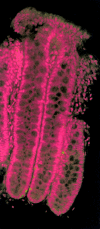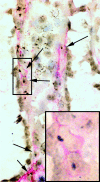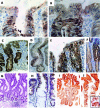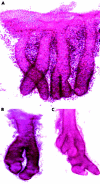Stem cell in gastrointestinal structure and neoplastic development
- PMID: 15138220
- PMCID: PMC1774081
- DOI: 10.1136/gut.2003.025478
Stem cell in gastrointestinal structure and neoplastic development
Figures









Similar articles
-
Epithelial stem cells in gastrointestinal morphogenesis, adaptation and carcinogenesis.Semin Cell Biol. 1992 Dec;3(6):445-56. doi: 10.1016/1043-4682(92)90015-n. Semin Cell Biol. 1992. PMID: 1489976 Review.
-
Gastrointestinal stem cells.J Pathol. 2002 Jul;197(4):492-509. doi: 10.1002/path.1155. J Pathol. 2002. PMID: 12115865 Review.
-
Gastrointestinal stem cells and their role in carcinogenesis.Int Rev Cytol. 1984;90:309-73. doi: 10.1016/s0074-7696(08)61493-x. Int Rev Cytol. 1984. PMID: 6389415 Review. No abstract available.
-
Transforming growth factor-beta signaling in stem cells and cancer.Science. 2005 Oct 7;310(5745):68-71. doi: 10.1126/science.1118389. Science. 2005. PMID: 16210527
-
Neural stem cell therapy and gastrointestinal biology.Gastroenterology. 2005 Dec;129(6):2092-5. doi: 10.1053/j.gastro.2005.10.033. Gastroenterology. 2005. PMID: 16344074 No abstract available.
Cited by
-
Optimizing homeostatic cell renewal in hierarchical tissues.PLoS Comput Biol. 2018 Feb 15;14(2):e1005967. doi: 10.1371/journal.pcbi.1005967. eCollection 2018 Feb. PLoS Comput Biol. 2018. PMID: 29447149 Free PMC article.
-
A comparison of epigenetic mitotic-like clocks for cancer risk prediction.Genome Med. 2020 Jun 24;12(1):56. doi: 10.1186/s13073-020-00752-3. Genome Med. 2020. PMID: 32580750 Free PMC article.
-
Indefinite for non-invasive neoplasia lesions in gastric intestinal metaplasia: the immunophenotype.J Clin Pathol. 2007 Jun;60(6):615-21. doi: 10.1136/jcp.2006.040386. J Clin Pathol. 2007. PMID: 17557866 Free PMC article.
-
The intestinal epithelium compensates for p53-mediated cell death and guarantees organismal survival.Cell Death Differ. 2008 Nov;15(11):1772-81. doi: 10.1038/cdd.2008.109. Epub 2008 Jul 18. Cell Death Differ. 2008. PMID: 18636077 Free PMC article.
-
Gastric carcinogenesis and the cancer stem cell hypothesis.Gastric Cancer. 2010 Mar;13(1):11-24. doi: 10.1007/s10120-009-0537-4. Epub 2010 Apr 7. Gastric Cancer. 2010. PMID: 20373071 Review.
References
-
- Brittan M. Bone marrow-derived stem cells contribute to multiple cell lineages in experimental colitis. J Pathol 2003;201(suppl):1A. - PubMed
-
- Krause DS, Theise ND, Collector MI, et al. Multi-organ, multi-lineage engraftment by a single bone marrow-derived stem cell. Cell 2001;105:369–77. - PubMed
-
- Korbling M, Katz RL, Khanna A, et al. Hepatocytes and epithelial cells of donor origin in recipients of peripheral-blood stem cells. N Engl J Med 2002;346:738–46. - PubMed
-
- Jiang Y, Jahagirdar BN, Reinhardt RL, et al. Pluripotency of mesenchymal stem cells derived from adult marrow. Nature 2002;418:41–9. - PubMed
Publication types
MeSH terms
Substances
LinkOut - more resources
Full Text Sources
Other Literature Sources
Medical
